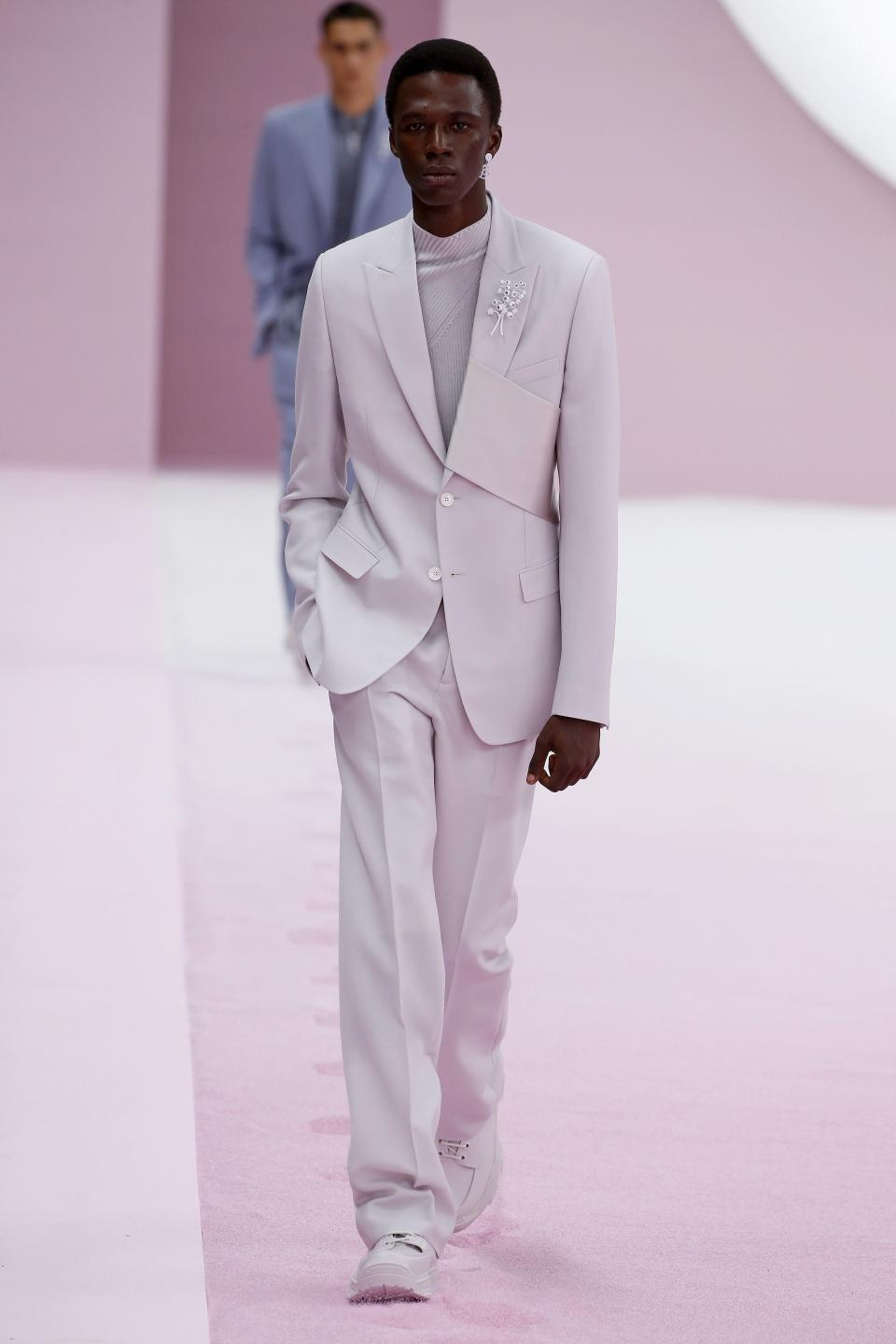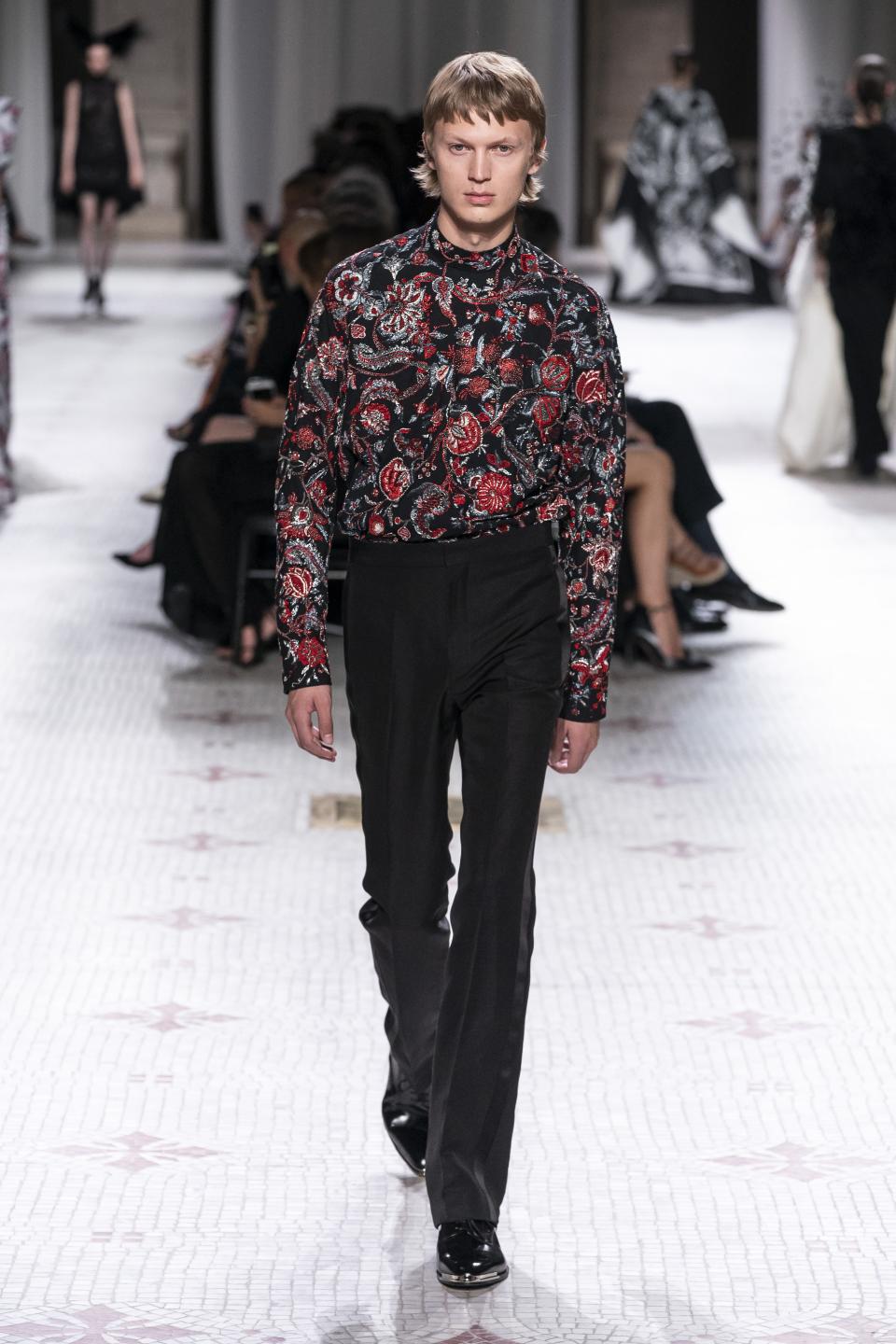In Paris, Men Are Invited into the Couture Dream
At the moment, haute couture—that most rarefied and rule-bound niche of the fashion industry, which is protected by law and governed by its own chamber of commerce in France—is the hottest thing happening. The front rows at last week’s shows in Paris, attended by both fashion-fan celebrities and the very rich people who actually buy couture, were animated with conversations about how couture is cool. Its scaled-back, more tasteful spectacles, the thinking went, allow designers and their fans (and, at couture week, their actual customers!) to think more about the clothes, the technical finesse, the champagne-buzzed wow factor.
Just look at Celine Dion, who has revitalized her whole public persona by being the woman who believes in the dream of the dress; who will wear the wild outfit, convenience or weather or occasion be damned; who will don a big, poofy Richard Quinn dress next to her two Weimaraners, conjuring Richard Avedon's photograph of a Balenciaga model with her big Parisian dog.
The runways are in on the dream, too. Pierpaolo Piccioli continues to expand on the fantasy of Valentino’s well-traveled but chateau-bound hostess; the house’s fabric sculptures in bold color combinations and ’70s floral prints almost look like an alternative medicine for calming the nervous mind of the global citizen. But couture isn’t just a plaything for the .01%: Along with Giambattista Valli's “big pink dress,” these designs have in fact set an agenda that’s rippled through the most commercial women’s ready-to-wear, as the racks at Barneys, Bergdorf's, and Neiman’s are stocked with more affordable versions of this dress for the woman who serves a whole fish barefoot while making jokes about Robert Mueller...or, well, imagines she does.
For the most part, the couture dream remains a woman’s domain, while men are having fun pulling from the silhouettes, attitude, and business apparatus of womenswear for ready-to-wear. But at a few houses—Margiela, Dior Homme, and Givenchy—designers are daring to combine couture with fashion’s other darling of the moment: menswear.
Last spring, John Galliano showed his last standalone men’s show for Maison Margiela and quietly launched a revolution. “It’s the highest form of dressmaking, but for men,” he said at the time on his podcast, a behind-the-scenes, rhapsodic soliloquy on fashion theory that arrives with each collection. The event may have happened during Paris Men’s Fashion Week, but the clothing, Galliano said, was genderless. Take his extensive use of satin-back crepe in that collection: The body’s temperature warms up the fabric, breaking it down, causing it to mold to the body. This is anathema, of course, to men’s tailoring, which treats the suit and all its descendants (like, idk, chinos!) as sacks of fabric that either render the human form a mostly straight line or are cleverly cut to disguise its flaws and play up its strengths (shoulders!).

After that collection, Galliano began showing his artisanal and ready-to-wear collections together, as what the house calls “co-ed.” (Margiela is not strictly—by law!—a couture house, so it instead shows these more elevated pieces under the banner term “artisanal.”) January’s artisanal show, for example, included both male and female models wearing experimental, gender-fluid garments, and Fall 2019 artisanal, shown in Paris last week, carried that concept even further. Galliano, who is perhaps the most theoretical designer in the couture biz, has been exploring glamour in its state of decay—“desire without reason,” as he said in this season’s podcast. He took trousers as his starting point and manipulated them with what he calls “nomadic cutting,” transforming them into new garments, like one he called the Watteau silhouette, modeled after a popular wedding-dress train in which the cape trails off the back.

Other designers are bringing couture more pointedly to men. At Dior Homme, Kim Jones’s major innovation in his year-plus at the house has been a tuxedo with a train—a long sash of duchess silk flowing from a meticulous piece of men’s tailoring. In his work, Jones uses fabrics like organza and satin, and hand-beading and embroidery techniques—the building blocks of couture. (For his first collection, he hand-embroidered a shirt in a pattern inspired by Christian Dior’s china set, with the couture ka-ching to match.) This season, the now-signature train was dipped in ombre pink, a dyeing technique right out of couture’s technical-flourish playbook. And the brooches on many of the men’s jackets were real flowers, calcified—the sort of godlike, triumph-over-nature dressmaking favored by Karl Lagerfeld.

Dior Homme : Runway - Paris Fashion Week - Menswear Spring/Summer 2020
EstropThe third biggie in couture menswear is Givenchy, whose designer, Clare Waight Keller, has integrated men’s looks into her couture runways since her first collection, for Spring 2017. Though she began as a menswear designer, Waight Keller’s techniques belie a couturier’s (read: traditionally womenswear designer’s) approach to fabric selection and embroidery. This season, for example, she showed a mirror-sharp frock coat with countless square-shaped sequins and embroidered with a beaded motif of beetles and flowers. These pieces are the (opulent) bread and butter of her red carpet business; see Chadwick Boseman at the Oscars in February, and Idris Elba at the 2018 Met Gala. It would be easy to picture either of those men in that coat.
These days, men’s fashion is great because it’s so tethered to reality. But now that it’s in a kind of golden age, it should feel free to lose touch, at least a little. It’s garments like the ones here that open the couture dream to men. Now all menswear needs to do is find its own Celine Dion.

Originally Appeared on GQ

